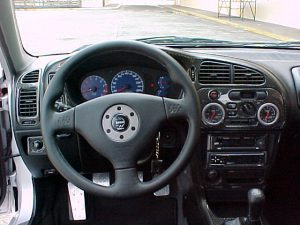How a water injection system works
Water injection systems are predominantly useful in forced induction (turbocharged or supercharged), internal combustion engines. Only in extreme cases such as very high compression ratios, very low octane fuel or too much ignition advance can it benefit a normally aspirated engine. The system has been around for a long time since it was already used in some World War II aircraft engines.
A water injection system works similarly to a fuel injection system with the difference that it injects water, or a mixture of water and alcohol, instead of fuel. Water injection is not to be confused with water spraying on the inlet air chargecooler’s surface, water spraying is much less efficient and far less sophisticated.
A turbocharger essentially compresses the air going into the engine in order to force more air than it would be possible using the atmospheric pressure. More air into the engine means, automatically, that more fuel has to be injected in order to maintain the appropriate stoechiometric value of the air/fuel ratio (around 14:1). More air and fuel into the engine leads to more power. However by compressing the inlet air the turbocharger also heats it. Higher air temperatures lead to thinner air and therefore an altered stoechiometric ratio which results to richer mixtures. Over-heated air intake temperatures can cause detonation.
Detonation, an effect also known as engine knock or pinging, occurs when the air/fuel mixture ignites prematurely or burns incorrectly. In normal engine operation the flame front travels from the spark plug across the cylinder in a predefined pattern. Peak chamber pressure occurs at around 12 degrees after TDC and the piston is pushed down the bore.
In some cases and for reasons such as a poor mixture, too high engine or inlet temperatures, too low octane fuels, too much ignition advance, too much turbo boost, etc. the primary flame front initiated by the spark plug may be followed by a second flame front. The chamber pressure then rises too rapidly for piston movement to relieve it. The pressure and temperature become so great that all the mixture in the chamber explodes in an uncontrolled manner. If the force of that explosion is severe some of the engine’s moving parts (pistons, rods, valves, crank) can be destroyed.
Detonation, in any engine, should always be avoided by either lowering inlet temperatures, using higher octane fuel, retarding ignition, hence lowering engine output, lowering engine blow-by (a situation in which high crankcase pressure sends oil fumes back inside the combustion chamber), running the engine a little richer than at the stoechiometric ratio, lowering the compression ratio and/or boost pressure, … .
Water injection is used to lower in-cylinder temperatures and burn the air/fuel mixture more efficiently thus helping avoid detonation.
In high pressure turbocharged engines the air/fuel mixture that enters the cylinders can, in some cases, explode prematurely (before the spark plug ignites) due to the extreme engine environment conditions. This situation is extremely destructive and results in severe engine damage (piston piercing). To avoid damaging the engine by detonation or pre-ignition phenomena, water is injected, along with fuel, in the combustion chambers in order to provide a water/air/fuel mixture which not only burns more efficiently and avoids detonation or pre-ignition but also provides additional inlet air cooling and, hence, denser air. The sole function of water injection is avoiding detonation.
There are mainly three variations of water injection systems. They are dependent of the location of the water injectors. The first technique consists of injecting water at the entrance of the intake manifold. The second injects water at the exit pipe of the intercooler. The third technique injects water at the entry of the intercooler and is only used in competition vehicles. In this latter variation most of the in-cylinder detonation prevention is done by injecting additional fuel which is then used as coolant (i.e. is not burned) and runs the engine above the stoechiometric ratio (i.e. rich).
How water injection works
The system is, usually, made up of 3 elements:
- A water injector (similar to a fuel injector)
- A high pressure pump (capable of attaining at least 3 to 4 bar pressure and sometimes even more)
- A pressure sensor connected to the inlet manifold
- An inlet air temperature sensor
Usually a water injection system is engaged when the inlet air temperature is exceeding a certain value, typically 40 degrees Celsius, and the engine is on boost. The most advanced systems add to the above electronic circuitry that provides 3D cartography similar to the one used in fuel injection systems. Cartography based devices take into account many more parameters such air/fuel ratio, throttle position and so on.

